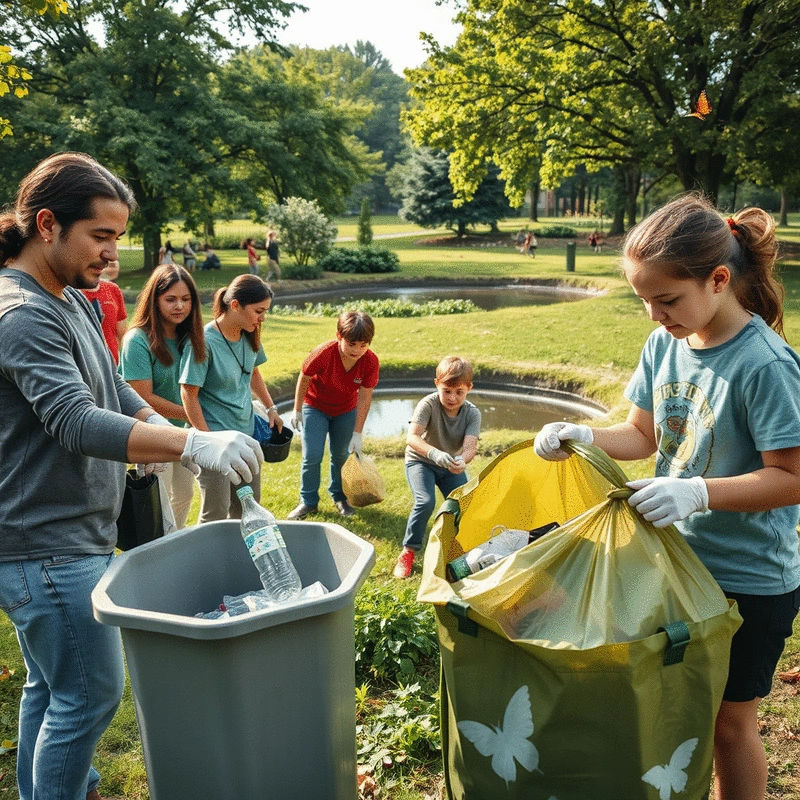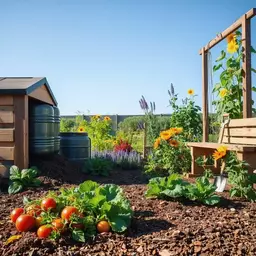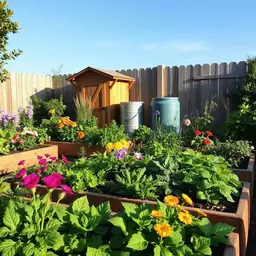Community Cleanups and Wildlife Health

What if your next weekend could help restore local wildlife habitats while beautifying your community? Community cleanups are not just about picking up litter; they are vital efforts that enhance both our environment and our connection with nature. Join the movement and discover the remarkable impact your small actions can have on wildlife conservation!
What You Will Learn
- Community cleanups are essential for removing harmful waste that can injure wildlife and pollute habitats.
- Organizing cleanups fosters community engagement, bringing neighbors together for a common purpose.
- Participation in cleanups supports local ecosystems, allowing diverse species to flourish.
- Scientific studies show that cleanups can significantly improve wildlife populations, such as increased bird diversity and more nesting sites for sea turtles.
- Success stories from cleanups demonstrate the positive transformation of local environments, like increased sightings of native wildlife and restoration of habitats.
- Community support and awareness campaigns are crucial for sustaining cleanup initiatives and driving higher engagement levels.
- Everyone can contribute to cleanups by participating, sharing experiences, and supporting local organizations.
Impact of Community Cleanups on Wildlife Populations
Insights from research reveal the positive changes in wildlife populations after community cleanups, highlighting the connection between a cleaner environment and healthier ecosystems. These efforts are crucial for suburban strategies for smart waste management.
Bird Diversity Increase
After cleanups, certain parks experienced an increase in bird diversity by up to 30%!
Sea Turtle Nesting Sites
Beach cleanups have shown a rise in sea turtle nesting sites.
Improved Fish Populations
Reduction in debris has been linked to improved fish populations in coastal waters.
Wildlife Habitat Restoration
Cleaner habitats provide better living conditions for various species to thrive.
Understanding the Role of Community Cleanups in Wildlife Conservation
When we think of community cleanups, the first image that usually comes to mind is a group of enthusiastic volunteers picking up trash in our local parks or streets. But community cleanups are much more than just gathering litter. They serve a vital purpose in wildlife conservation! By organizing these events, we not only beautify our neighborhoods but also create healthier environments for the animals that share our spaces.
The primary objective of community cleanups is to remove waste from public areas, making them cleaner and safer for both people and wildlife. This means less trash in parks where children play, and fewer harmful materials in habitats where wildlife lives. Moreover, the act of cleaning up fosters a strong sense of community and encourages residents to take pride in their surroundings. It’s a collaborative effort that connects us, creating a shared goal for the greater good!
Defining Community Cleanups and Their Purpose
So, what exactly are community cleanups? They are organized efforts where volunteers come together to pick up litter, clean parks, and spruce up our shared environments. These events aim to tackle pollution and enhance the aesthetics of our neighborhoods while ensuring that local wildlife has a safe habitat. Think about how many times you've seen litter in your local park—each piece can harm an animal if ingested or cause disruption to their natural habitat! To learn more about how to get involved, check out our guide on joining eco-friendly cleanup efforts.
- Remove harmful waste: Clearing trash from ecosystems directly benefits wildlife by preventing injury and pollution.
- Encourage community engagement: Cleanups cultivate relationships among neighbors, fostering a sense of teamwork.
- Promote a cleaner environment: A cleaner community leads to healthier ecosystems where wildlife can thrive.
As an advocate for environmental sustainability, I’ve seen firsthand how these efforts transform not only our surroundings but also our community spirit. Each cleanup is a small step toward a better future for wildlife and for us. It’s about creating a ripple effect—when we take action together, the impact is significant!
The Growing Importance of Local Wildlife Conservation Efforts
Wildlife conservation has become increasingly important as urbanization and pollution continue to threaten natural habitats. Local initiatives, like the ones organized by Greener Suburbs, play a crucial role in preserving the delicate balance between human activity and wildlife needs. By participating in cleanups, we contribute to larger conservation efforts that help protect species that might otherwise disappear!
Community cleanups are essential because they:
- Support local ecosystems: By reducing litter, we help maintain the health of ecosystems that wildlife depends on.
- Encourage biodiversity: Cleaner environments allow various species to flourish alongside each other.
- Raise awareness: Engaging in cleanups helps educate community members about environmental issues affecting local wildlife.
As we come together for cleanups, we not only help local wildlife but also nurture a culture of awareness and responsibility among our neighbors. It’s rewarding to see this connection grow as we work hand in hand towards a shared vision for our environment! How about joining us for our next cleanup event? Your participation can make a world of difference!
We Want to Hear From You!
What motivates you to participate in community cleanups? Share your thoughts below!
Measuring the Impact of Cleanups on Wildlife Populations
When we talk about community cleanups, we often think about the immediate benefits—like a cleaner park or a litter-free beach. However, the long-term impact on wildlife populations is equally important. Scientific studies have begun to quantify how these cleanup efforts lead to healthier ecosystems and a boost in local wildlife. For instance, researchers monitor changes in animal populations before and after cleanups, providing valuable data on how our efforts are helping nature thrive.
Some of the key findings include a reduction in plastic debris in habitats, which leads to healthier feeding grounds for birds and aquatic life. Furthermore, cleaner environments attract more species, fostering a robust ecosystem. Isn’t it amazing to think that by picking up litter, we’re not just beautifying our neighborhoods, but also playing a role in wildlife conservation? For more details on organizing successful events, see our post on organizing effective community cleanups.
Scientific Studies and Data-Driven Insights
Research indicates that community cleanups can lead to significant changes in wildlife populations. For instance, studies show that after cleanups, certain bird species return to areas previously abandoned due to pollution. Here are some notable insights from recent research:
- After cleanups, some parks experienced an increase in bird diversity by up to 30%!
- Beach cleanups have shown a rise in sea turtle nesting sites.
- Reduction in debris has been linked to improved fish populations in coastal waters.
These findings highlight the ripple effect that our cleanup efforts can have on wildlife. By creating cleaner habitats, we’re providing better living conditions for various species to thrive!
Long-Term Monitoring and Success Stories
Stories of success are inspiring and illustrate the profound impact of our community cleanups. One such example comes from a neighborhood cleanup organized by Greener Suburbs, where we saw a remarkable transformation in our local park. After just one year of consistent cleanups, we received reports of:
- Increased sightings of foxes and raccoons in the area.
- A notable rise in butterfly populations, which are vital for our ecosystem.
- A flourishing of native plants returning to the region.
These stories reflect the commitment of our community members to restore local habitats. I encourage everyone to share their experiences as these success stories motivate others to join the cause!
FAQ: Community Cleanups and Wildlife Conservation
Here are some frequently asked questions about the impact of community cleanups on wildlife conservation.
- What is the primary purpose of community cleanups?
- Community cleanups primarily aim to remove waste from public areas, making them cleaner and safer for both people and wildlife. They also foster community engagement and pride.
- How do community cleanups benefit wildlife populations?
- Cleanups directly benefit wildlife by preventing injury from harmful waste, reducing pollution in habitats, and creating healthier environments that lead to increased biodiversity and flourishing species. Scientific studies have shown increases in bird diversity and sea turtle nesting sites, among other positive impacts.
- What evidence supports the positive impact of cleanups on wildlife?
- Research and long-term monitoring have shown significant improvements, such as up to a 30% increase in bird diversity in cleaned parks, a rise in sea turtle nesting sites after beach cleanups, and improved fish populations due to reduced debris in coastal waters.
- How can individuals get involved in local cleanup efforts?
- Individuals can get involved by checking for local events organized by groups like Greener Suburbs, bringing friends and family, and sharing their participation on social media to inspire others.
- Why is community support and funding important for cleanup initiatives?
- Community support and funding are crucial for sustaining cleanup efforts. This includes providing funding for supplies, offering venues for events, and volunteering time. Strong community involvement builds a network that ensures long-term impact.
Encouraging Community Participation and Engagement
Community involvement is the backbone of successful cleanup initiatives. The more people we engage, the larger the impact we can achieve. It’s essential for individuals to know how they can contribute, and I believe everyone can play a part in making a difference!
How Individuals Can Get Involved in Local Cleanups
Are you ready to roll up your sleeves and dive into a cleanup? Here are some simple steps to get involved in local efforts:
- Check out local events organized by groups like Greener Suburbs.
- Bring your family and friends along for a fun day outdoors!
- Share your participation on social media to inspire others!
Together, we can create a strong movement toward a cleaner environment. Every little effort counts!
The Importance of Community Support and Funding
To successfully carry out cleanup initiatives, community support is crucial. Local organizations, businesses, and community members can contribute in various ways:
- Providing funding for cleanup supplies like trash bags and gloves.
- Offering venues for organizing cleanup events.
- Volunteering their time and effort during cleanup days.
When we come together as a community, we build a network of support that ensures our cleanup efforts are sustainable and impactful. This support is also vital for organizing a neighborhood beautification project that goes beyond just cleanups.
Public Awareness Campaigns to Drive Engagement
Awareness campaigns can significantly boost community engagement in cleanup activities. Here are some effective strategies that have worked wonders:
- Creating engaging social media posts that highlight cleanup successes.
- Running contests or challenges that encourage participation, like “Cleanest Block” competitions!
- Partnering with local schools and organizations for educational programs.
By raising awareness, we capture the attention of more volunteers and create a stronger sense of community responsibility toward our environment. These initiatives often work hand-in-hand with greener communities through beautification projects.
Conclusion: The Lasting Impact of Community Cleanups on Wildlife Conservation
As we wrap up our exploration of community cleanups and their role in wildlife conservation, it’s clear that these initiatives yield substantial benefits. From enhancing local biodiversity to fostering community pride, every cleanup counts! So, let’s band together and make it a point to participate in local cleanups—let’s keep our neighborhoods and wildlife thriving for future generations.
Recap of Key Points
Here is a quick recap of the important points discussed in the article:
- Community Cleanups: Organized efforts that not only beautify neighborhoods but also protect local wildlife by removing harmful waste.
- Encouraging Engagement: Cleanups foster community bonds and instill a sense of pride among residents.
- Wildlife Conservation: Clean environments support local ecosystems, encourage biodiversity, and raise awareness about environmental issues.
- Scientific Evidence: Studies show significant increases in wildlife populations after cleanups, demonstrating their long-term impact.
- Community Involvement: Everyone can contribute by participating in local cleanup events, sharing experiences on social media, and supporting initiatives through funding or volunteering.
- Awareness Campaigns: Effective strategies such as social media engagement and educational programs can drive community participation in cleanups.
Popular Posts
 What if your next weekend could help restore local wildlife habitats while beautifying your communit
What if your next weekend could help restore local wildlife habitats while beautifying your communit
 What if your local business could lead the charge in transforming your community into a recycling po
What if your local business could lead the charge in transforming your community into a recycling po
 Gardening isn’t just a pastime; it’s a chance to make a difference in our suburban landscapes. B
Gardening isn’t just a pastime; it’s a chance to make a difference in our suburban landscapes. B
 Did you know that creating an eco-friendly garden can significantly enhance your home’s value and
Did you know that creating an eco-friendly garden can significantly enhance your home’s value and
